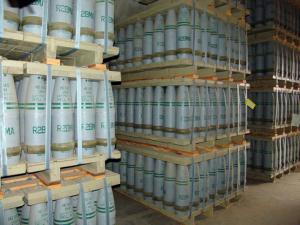ISISISIS used mustard gas in Iraq: UN watchdog
A source at the UN chemical weapons watchdog, the Organization for the Prohibition of Chemical Weapons (OPCW), said that in 2015 ISIS attacked Kurdish forces in Iraq with mustard gas. It was the first documented use of chemical weapons in the country since Saddam Hussein used chemical weapons against Kurdish civilians in 1998.

Pallets of 155mm poison gas shells // Source: wikipedia.org
A source at the UN chemical weapons watchdog, the Organization for the Prohibition of Chemical Weapons (OPCW), said that in 2015 ISIS attacked Kurdish forces in Iraq with mustard gas. It was the first documented use of chemical weapons in the country since Saddam Hussein used chemical weapons against Kurdish civilians in 1998. OPCW sources told the Reuters that laboratory tests had showed that thirty-five Kurdish fighters were sickened by sulphur mustard while battling ISIS in Erbil in August 2015.
In October, OPCW concluded that mustard gas was used in 2015 in Syria.
RT reports thatexperts were uncertain of how the group might have obtained chemical weapons or whether it had access to more.
Another diplomat said Syria’s stockpile was a possible source of the sulphur mustard used in Iraq. This would mean Damascus had not fully disclosed its chemical weapons program, as required by the agreement reached in 2013.
“If Syria has indeed given up its chemical weapons to the international community, it is only the part that has been declared to the OPCW and the declaration was obviously incomplete,” one diplomat told Reuters.
Syria agreed to give up its chemical weapons stockpile, and dismantle its chemical weapons production facilities, after 1,200 Sunni civilians were killed by a Syrian army’s Sarin nerve gas on a Damascus suburb in August 2013.
Iraq’s own chemical arsenal, part of a WMD program the United States pointed to as the reason for the 2003 invasion, had been destroyed and dismantled in the mid-1990s although U.S. troops did encounter old Saddam-era chemical munitions during the 2003-11 occupation.
Hamish de Bretton-Gordon, a specialist in biological and chemical warfare, told the Guardian that ISIS may have developed their own chemical weapons capability.
“I’m pretty convinced that the mustard IS are using in Iraq is made by them in Mosul,” he said, referring to the main city which ISIS has occupied since 2014. “They have all the precursors at hand from the oil industry and all the experts at hand to do it.”
Sulphur mustard is a Class 1 chemical agent, which means it has very few uses outside chemical warfare. I was widely used in the First World War.
